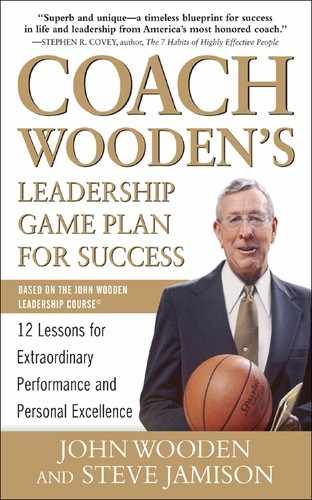PART I
ORIGINS OF LEADERSHIP
A COMPASS FOR CORE VALUES
THE ORIGIN OF MY LEADERSHIP
The best man I’ve ever known is my father, Joshua Hugh Wooden. He was also my greatest teacher. What Dad taught me, and how he taught it, had a most profound impact on what I did professionally.
In style and substance, much of what I taught in 40 years as a leader and coach can be traced back in some manner to his own teaching, his own example back on our farm in Centerton, Indiana.
My father had a commonsense kind of wisdom. A man of few words, when Joshua Hugh Wooden said something, he really said something.
|
My dad |
Four of his important guiding principles have been a compass for me in my years of teaching, important words and deeds I have tried to live by and teach others. Dad’s principles, the points on his compass, had to do with ethics and attitude. I didn’t know it at the time, but he was giving me what is at the core of strong leadership.
Try your hardest; make the effort; do your best.
A MESSAGE REPEATED OFTEN
BY JOSHUA HUGH WOODEN.
Ethics and Attitude
Be more concerned with your character than
with your reputation. Character is what you really are.
Reputation is what people say you are.
Character is more important.
John Wooden’s leadership was “character-based” before the word was invented. His philosophy and methodology are grounded in straightforward attitudes, values, and principles taught by his father, Joshua Hugh Wooden. The genesis of John Wooden’s “character-based” leadership is traced back to what he learned growing up on a small farm in Centerton, Indiana, in the 1920s. Here are the four navigation points on John Wooden’s compass for life and leadership that he learned from his father:
I am not what |
1. THE GOLDEN RULE
According to John Wooden, “My father came as close to living the Golden Rule as anyone I have ever known.”
The Wooden family farmhouse, Centerton, Indiana
There is a choice you have to make in
everything you do. So keep in mind that in the end
the choice you make makes you.

Coach John Wooden, Dayton (KY) High School, 1932
The example of Joshua Hugh Wooden’s “living the Golden Rule” made a profound and lasting impression on the future teacher and coach. Consciously and unconsciously “treating others as you would have them treat you” became a near-inviolable tenet of John Wooden’s leadership. It is the first navigation point on his compass of character-based leadership.
2. DAD’S TWO SETS OF THREES
Joshua Hugh Wooden repeatedly reminded his four sons—Maurice (“Cat”), Johnny, Dan, and Bill—of his two lists (sets) with instructions offering directives on ethics and attitude. The first set gave three instructions on integrity:
1. Never lie.
2. Never cheat.
3. Never steal.
The second set gave three suggestions on how to face adversity:
1. Don’t whine.
2. Don’t complain.
3. Don’t make excuses.
Joshua Wooden and sons Billy, Dan, Johnny, and “Cat”
Joshua Hugh Wooden’s Two Sets of Threes offer straightforward advice; simple to understand, not so simple to abide by. They became the second navigation point on John Wooden’s compass.
3. THE CAUTION AGAINST COMPARISONS
Throughout his early years, the future coach was told by his father to do the following when it came to the competition and comparing himself to others: “Johnny, don’t worry about being better than somebody else, but never cease trying to be the best you can be. You have control over that. Not the other.” Eventually this advice would spur him to redefine success in a manner that was radical. In the process, John Wooden largely freed himself from the judgment of outsiders. What mattered most was not how he fared in comparison to others, but how close he came to his father’s advice: ceaseless effort in bringing forth his own potential. He allowed no one, not even the scoreboard, to tell him whether or not he had succeeded in achieving this. John Wooden became the only judge of his success that mattered to John Wooden. It is the third navigation point.
Strive to accomplish |
4. DAD’S SEVEN-POINT CREED
Upon graduation from a country school in Centerton, Indiana, John Wooden received a gift from his father: a two-dollar bill. More important, Joshua Hugh Wooden also gave his son a 3 × 5 card on which he had written what would become the fourth navigation point:
“Seven Suggestions to Follow”
1. Be true to yourself.
2. Help others.
3. Make each day your masterpiece.
4. Drink deeply from good books—including the Good Book.
5. Make friendship a fine art.
6. Build a shelter against a rainy day.
7. Pray for guidance, count and give thanks for your blessings every day.
SUMMARY
John Wooden is frequently cited as an example of a values-based leader, one whose positive and productive principles were intrinsically woven into his system. What he did on the court reflected who he was off the court. Who he was, and is, is a direct reflection of the basic teachings of his father, Joshua Hugh Wooden, and the compass he gave his son for navigating through life and leadership.
THE EVOLUTION OF MY LEADERSHIP
Ability may get you to the top,
but it takes character to stay there.
Three mentors had a profound influence on my leadership in both style and substance. Each man contributed significantly to what I embraced and taught as a coach.
While my father provided the foundation for my philosophy, the compass for ethics and attitude, these three mentors—all coaches—were crucial to its evolution. Obviously, I worked hard to improve my teaching as the years went on, increasing my self-control, patience, and more, but these men had a tremendous impact on what I taught and how I taught it.

Before you can be a good leader,
you must be a good follower.
DEFINE THE STAR, TEACH DETAILS, EXTEND YOUR FAMILY
Define the Star
EARL WARRINER: THE STAR OF THE TEAM IS THE TEAM
John Wooden attended Centerton Grade School—one mile down a dirt road from the family farm. The principal and basketball coach of the school, Mr. Earl Warriner, taught one of the strongest lessons in team building that John Wooden ever learned; namely, no single person is more important than the team.

A leader must accomplish the difficult task of getting those
on the team to believe that “we” supersedes “me.”
Who is the star of the team?
If a grade school basketball team could have a “star,” Joshua Hugh Wooden’s son Johnny was it; the “gunner” more likely to make a basket than not. One day he forgot his basketball jersey and tried to use his position as “most important player” to force a teammate to run back to the Wooden farm and fetch it for him before the game started.
A Simple Recipe |
Coach Warriner would not allow it. Instead, he benched young Wooden and kept him on the bench even though it meant losing the game. “Some things are more important than the score, Johnny,” was his explanation. He was telling the young “star” that the star of the team is the whole team.
John Wooden never forgot this message, and its application was seen on all of his teams, including those that won 10 national championships.
As a coach, it was a fundamental principle of his philosophy. Even with superstars such as Kareem Abdul-Jabbar or Bill Walton, the team was the star.
Teach Details
GLENN CURTIS: TEACH DETAILS
Glenn Curtis, John Wooden’s coach at Martinsville High School, stressed the importance of basics—fundamentals—and how to teach them. Coach Curtis would break the mechanics of basketball down into small and separate pieces.

Indiana High School basketball champions, 1927. Johnny Wooden, second row, second from right.
The players would practice each individual element until it was perfected. Then they would put the pieces back together into a whole under the direction of Coach Curtis.
This applied to running routes on plays, the mechanics of passing, shooting, rebounding, and everything else. Often practice consisted of drills without the basketball.
Later, Coach Wooden took this approach much farther in his own system—eventually even showing players how to correctly put on socks and lace and tie shoelaces on sneakers to prevent blisters.
In fact, there are |
Basics—details, fundamentals—are the underpinning of great performance in basketball or business. An organization will not achieve or sustain success when sloppiness in the execution of relevant details is permitted. John Wooden began learning how to squeeze sloppiness out of preparation and performance from Coach Curtis. He applied it most effectively in building the UCLA basketball dynasty.
Basics—details and fundamentals—are the underpinning of great performance in basketball or business.
Extend Your Family
WARD “PIGGY” LAMBERT: YOUR TEAM IS YOUR EXTENDED FAMILY
Purdue University’s Ward “Piggy” Lambert was “the most principled coach I have ever known,” according to John Wooden. Mr. Lambert’s impact on his young guard—a three-time all-consensus All American—is profound.
As a mentor Coach Lambert taught many things in many ways. This included his “Big Three”: Condition, Fundamentals, and Team Unity (later, they would be included in the heart of Coach Wooden’s Pyramid of Success).
Most important, John Wooden learned from Coach Lambert’s example that the team becomes a leader’s extended family. Time and again the great Purdue coach made decisions that were in the best interests of “his boys” even when fans and alumni opposed him.
Successful |
When the Purdue Boilermakers—Big Ten champions—were invited to appear in a tournament at New York’s Madison Square Garden, Coach Lambert turned it down because he believed the big city environment—commercialization, gambling, and other temptations—was not in the best interests of the players.
His care and concern for their welfare precluded putting them in a setting that he wouldn’t condone for his own children.
For Coach Lambert, the team was truly his extended family. “Piggy” Lambert was stern, a taskmaster and a fiery competitor, but he loved his team even to the point of making decisions that caused him to be harshly criticized by outsiders. He stood up for “his boys” even when he had to stand alone. (A few years later, a gambling scandal at the New York tournament involving several college players proved Coach Lambert correct.)
Johnny Wooden and Purdue Coach “Piggy” Lambert
The principled leadership of Ward “Piggy” Lambert was the model for what John Wooden set out to become as a coach.
He stood up for his team even when
he had to stand alone.
SUMMARY
An effective leader is forged by events, experience, observation, and education. All of this was true in John Wooden’s own evolution in leadership, teaching, and coaching. However, the impact of Earl Warriner, Glenn Curtis, and Ward “Piggy” Lambert on his philosophy and methodology is surpassed only by that of his father, Joshua Hugh Wooden.
When he became a teacher of basketball, a leader of teams, much of what John Wooden tried to do was a direct reflection on what these mentors had taught while he had been their student.







 COMPASS CHECK
COMPASS CHECK


















